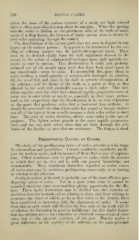Page 760 - My FlipBook
P. 760
770 DENTAL CARIES. —
where the mass of the carious contents of a cavity are light colored'
there is often some discoloration about its margins. When the opening
into the cavity is hidden on the proximate sides of the teeth or under
cover of a deep fissure, the location of many carious areas is shown by
their color appearing through the enamel.
The discoloration of the carious parts does not seem to depend in any
degree on the carious process. It appears to be determined by the set-
tling of coloring matters into the partly-decomposed tissue. These
seem to be derived chiefly from the dark sulphurets formed in the
mouth by the action of sulphuretted hydrogen upon such metallic ele-
ments as may be present. This discoloration is easily and perfectly
imitated out of the mouth upon teeth that have been acted upon to
any considerable extent by acids. To accomplish this, place them in
water holding a small quantity of sulphuretted hydrogen in solution^
fill the vessel full, and place in the dark to prevent decomposition of
the solution ; and the tissues of the teeth, to a point as deep as that
affected by the acid, will gradually assume a dark color. This fact^
taken together with the other fact—that all rapidly-progressive cases of
caries are in color white or nearly so, especially in their inner parts
leads to the supposition that the discoloration is in no wise dependent
on the agent that produces caries, but is borrowed from without. It
should be mentioned also that when caries has ceased or become station-
ary all of the injured tissue usually assumes a dark color within a short
time. The color of caries, therefore, affords some index to the rate of
progress. The lighter colors pertain to the more rapidly progressive
cases, and the very dark colors, those that are dark through the sub-
stance of the dentine, to cases that are stationary. The fungus is dead.
Predisposing Causes of Caries.
The study of the predisposing causes of caries presents a wide range
for observation and speculation. Certain conditions manifestly predis-
pose the teeth to caries, and the manner of their effect is easy of explana-
tion. Other conditions seem to predispose to caries, while the manner
in whicli they act to that end is, with our present knowledge, not
demonstrable. jNIany conditions heretofore regarded as active causes
of caries nuist now be viewed as predisposing causes only, or as having-^
no relation to the affection.
Faidty formation of the teeth is probably one of the most effective pre-
disposing causes of caries. Yet in a more strict sense it cannot be
regarded otherwise than as a condition giving opportnnity for the dis-
ease. These fauUy formations may be divided into two varieties of
deviation from the normal—those relating to form, and those relating to-
structure, the latter of which, so far as they relate to the dentine, have
been considered in connection with the ])henomena of caries. It seems
clear that an acid which will dissolve the lime salts of the teeth will do
so whether the fi)rmation be good or indifferent ; for this faulty forma-
tion has relation not to the molecular or chemical composition of these
salts, but to the jihysical structui-e of the part. Density makes a
great difference in the rapidity of the solution, on the same principle


